This was published 5 months ago
This moving and vibrant Rising show is a must-watch
By Andrew Fuhrmann, Cameron Woodhead, Tony Way and Vyshnavee Wijekumar
DANCE
Gurr Era Op ★★★★
Rising Festival, Arts Centre Melbourne, until June 16
For anyone interested in contemporary dance, the program for this year’s Rising Festival must feel a little underwhelming. This is perhaps strange, because the festival artistic director, Gideon Obarzanek, is himself a celebrated contemporary dance choreographer known for pushing the boundaries of the form.
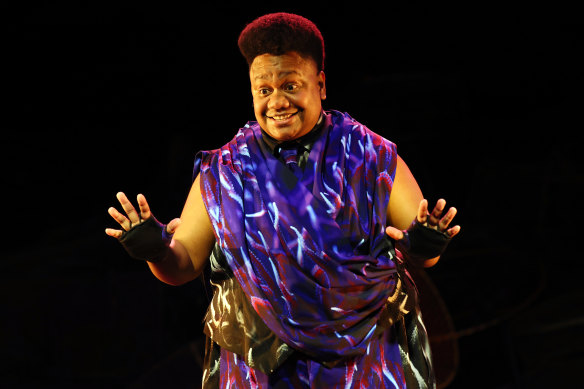
This beautifully composed dance theatre piece is like a sea breeze: it blows strong and tastes fresh. Credit: Prudence Upton
So, what’s he got on the menu? Last week there was a new duet by Antony Hamilton and a gothic contemporary dance opera by Melanie Lane. This week there’s a new duet by Lucy Guerin. At first glance, that might not look too bad, but Obarzanek, Hamilton, Guerin and Lane all work within the same close network of influences and associations.
For a start, Hamilton is artistic director of the company that Obarzanek founded. And Guerin, of course, is Obarzanek’s partner and occasional collaborator. Lane, meanwhile, danced for many years in Guerin’s company. While these connections don’t signify anything much in themselves, they do make the contemporary dance options at this year’s festival seem rather limited.
So we should be thankful for Ghenoa Gela’s Gurr Era Op. This beautifully composed dance theatre piece, featuring Gela and performers Taryn Beatty and Aba Bero, is like a sea breeze: it blows strong and tastes fresh. And it is, whatever else, something new and vibrant for Melbourne.
All three performers are Torres Strait Islander women, born in mainland Australia, who maintain a strong connection with their island heritage. Through a combination of story, reminiscence, song and dance, they offer a passionate plea for action on climate change, while also raising challenging questions about memory, tradition and what it means to lose a homeland.
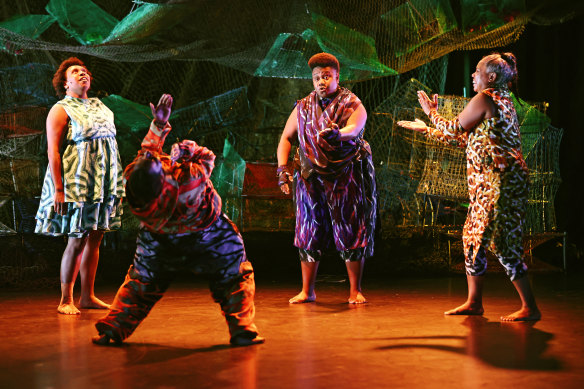
The performers recount their ancestry, weaving the past into the present.Credit: Prudence Upton
The performance begins with the three women on a stage – designed by Katy Moir – piled with fishing cages of all shapes and sizes. Initially, these derelict structures suggest ruins left by the sea or forgotten by its people, but we soon learn that for the women they are also evocative tokens of Erub, their island home.
The performers recount their ancestry, weaving the past into the present, before sharing memories of island life, such as the first island song they remember hearing. A rendition of Monkey and the Turtle adds a touch of fun and whimsy. This is followed by an extravagant description of an imagined family feast.
At intervals, the netting backdrop transforms into a spectral world, illuminated by strange lights. Glowing designs resembling dharis – dance headdresses – float across the stage, representing spirits who foresee the coming flood. For these spirits, symbols of memory and tradition, displacement is a kind of death. When the islands are gone, they ask, will all be forgotten?
Choreography is one of the stronger elements of Gurr Era Op, with the trio frequently working in tight unison and engaging variations. The three central dance sections are tense and muscular, expressing controlled anger through hunched postures and yet thrusts of the arms and neck.
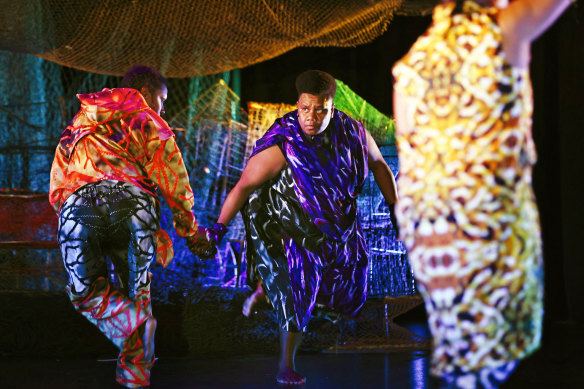
Gurr Era Op is a moving and generous performance.Credit: Prudence Upton
In fact, dance and movement permeate the entire performance. There are fragments of totem animal dances – the tiger shark and stingray, the dingo and the crocodile – and expressive gestures to illustrate the descriptions of food and eating (kai kai). In fact, at every moment, the women seem to be dancing – remembering island rhythms – even as they shift around the scenery.
A notable moment occurs when the house lights come on and Gela invites audience members to share their own experiences of memories of place. It’s a moment in which the show might have transformed. The invitation, however, was not taken up during the Wednesday show, despite the generally positive atmosphere. Perhaps this reluctance hints at something in the background of this show: a national habit of forgetfulness? The performers describe settler Australians as essentially displaced, people from elsewhere, and urge the audience to stand up for those soon to be displaced by climate change. And yet, if we’re so complacent about our own displacement, what empathy can we offer?
This may explain the darker elements of this production and apocalyptic tone of the final scenes, where a sea wall of fishing cages is built. There’s anger and determination in this show, but a sort of fatalism as well. Still, Gurr Era Op remains a moving and generous performance. There are glimpses of paradise—the crystal waters and white sands – and of a deep shared love for a living culture.
Reviewed by Andrew Fuhrmann
THEATRE
8/8/8: Rest ★★★
Rising Festival, Arts Centre Melbourne, until June 9
I know Arts Centre Melbourne intimately, but not until spending an entire night there at 8/8/8: Rest have I truly fallen in love with the place.
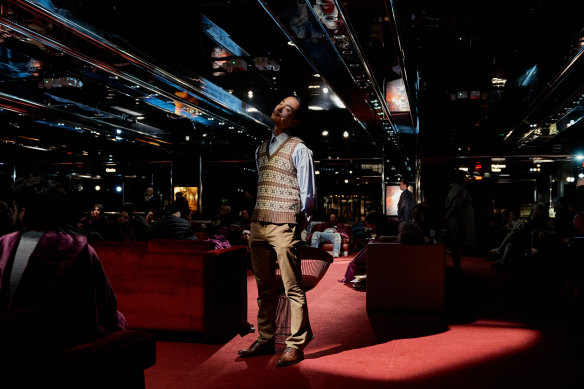
8/8/8: Rest is the second instalment in a sprawling 24-hour theatre trilogy.Credit: Amelia Dowd
Let’s face it, the Arts Centre is no Sydney Opera House. It never will be, and like most Melburnians, I regard it with a mixture of affection and pity.
The squat brutalist exteriors. The kitsch spire, vaulting into the heavens. And the plush, almost mobsterish opulence (straight from the “greed is good” phase of mid-’80s capitalism) decorating the warren of theatres underneath.
Architecturally, it tests the boundaries of aesthetic coherence, as does 8/8/8: Rest, an eight-hour, site-specific durational performance set within its womb-like embrace.
This is the second instalment in a sprawling 24-hour theatre trilogy from Harriet Gillies, Marcus McKenzie and collaborators, split over eight hours each of work, rest and play. It kicked off with 8/8/8: Work at last year’s Rising festival, which explored the exploitation and absurdity of contemporary workplace culture from 9 to 5 (and in a signature irony, sometimes made the audience feel like unpaid interns).
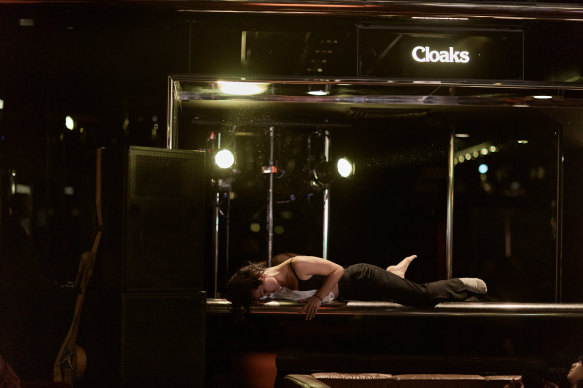
8/8/8: Rest might pose an even tougher challenge for those who aren’t night owls or insomniacs.Credit: Amelia Dowd
8/8/8: Rest might pose an even tougher challenge for those who aren’t night owls or terrible insomniacs. The piece runs from 9pm to 5am, interrogating the commodification of sleep – among other things – while keeping you up all night.
It begins with corporate satire. Audience members don lanyards and become delegates at a conference of sleep experts where almost everything that can go wrong, does. Short lectures on the latest scientific research are often waylaid: one speaker takes DMT and wafts into a pre-verbal trance onstage, while dodgy corporate entertainment (reworked by a children’s entertainer for an adult audience) is needed to cover serious misconduct from the conference’s chief corporate sponsor.
As we approach midnight, however, the conference dissolves, the audience gets monogrammed “Snuggies” to wear, and we step into a surreal, dreamlike night journey, where the Arts Centre itself speaks to us, where swamp creatures roam and paintings come to life, and where the logistical nightmare of making a show of this scale at the Arts Centre is comically exposed.
The last part is as bizarre as any of the surrealist physical theatre in the show and involves an extended sequence (which seems to use verbatim email exchanges between artists and staff) that re-enacts the ordeal of removing an Alice in Wonderland puppet exhibition from the Arts Centre foyer.
The saga of the vitrines (glass display cases for the puppets) unleashes a Kafka-like maze of bureaucratic absurdity – and perhaps in a sign of things to come, shows how inseparable work and rest can be – right at the point where sleep deprivation starts to bite. It’s like a lucid dream, and the piece only gets more hallucinatory as the wee hours start to stretch towards dawn.
8/8/8: Rest does have mercy on us. A beanbag-strewn sleep and meditation space has been arranged so you can nod off if you desire, while insomniacs can party at an impromptu rave, elsewhere in the building.
There are longueurs, of course, but this is an intricate and provocative investigation of how we approach the third of our lives we should spend asleep. It’s also a triumph of site-specific performance. This is Arts Centre Melbourne as you’ve never seen it before: an iconic ugly duckling, dreaming it’s a swan.
Reviewed by Cameron Woodhead
THEATRE
Collaborator ★★★
Daniel Kitson, Rising Festival, Lawler Studio, until June 23
Full disclosure. I performed in this show and may have a conflict of interest. My part was small, it’s true. I only had one line, “Wankers!“, and you might think that isn’t much to work with, but I really inhabited the role. It was a strong showing. Primal. Almost a tour de force, if I can say such a thing without raising the suspicion of false modesty.
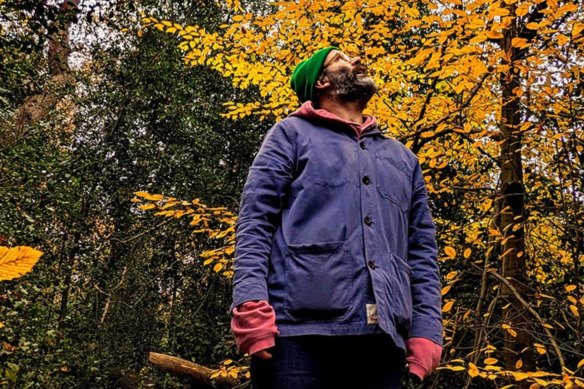
Daniel Kitson’s show, Collaborator, takes aim at audience participation.
I did have an unfair advantage, of course. Theatre critics? We’re just so accustomed to dealing with that level of nuance. A gift of a line in the right hands, “Wankers!”, and it’s easy to speak from the heart when you’ve suffered workplace exposure to questionable levels of audience participation for years.
It’s the theatrical equivalent of asbestos — requires proper handling — and my cameo was deeply felt, as I’m sure the rest of the 170-odd strong cast of Collaborator would agree.
Stand-up comedian-turned-theatre artist Daniel Kitson hates audience participation as much as anyone, so the perverse bastard has gone and written a play about it with up to 200 parts.
Collaborator moves beyond critique and comedy into a style of experimental participatory theatre that creates an instant sense of community.
Each part has its own script, handed out among spectator/participants at the start of the show and, although you can elect a non-speaking role if your aversion is total, there are so many roles to fill that everyone is basically coerced into joining the debacle.
Fear not. Most parts are micro, and you might get a chance at a scripted heckle, or to show off your Kitson super-fandom, as the play unfolds.
There’s only one named role, Kitson’s antagonist Keith, played by the first audience member dragooned into assisting. Keith is a reluctant collaborator, and he’s not alone in his ambivalence.
Incessant interjections, often making a problem of the play’s dubious gambit, keep deferring “the start of the show”, and Kitson soon has a rebellion on his hands, with Keith leading the charge.
Collaborator may be a touch anaemic as a critique of audience participation, though it raises many issues: power dynamics between performer and audience, questions of consent and implied consent, its use in stand-up comedy and the commodification of schadenfreude, the potential for exploitation and so on.
What it doesn’t acknowledge is that audience participation is the norm in many performance traditions; that sitting down in polite silence to passively watch a play is a style of theatre influenced by class and culture and history, and even that tradition is more honoured in the breach than the observance.
It probably spends too much time pre-empting criticisms (including this one) to delve too far into the philosophy and ethics underlying a complex, hugely variable aspect of live performance, but it’s fun.
Kitson is a fun wanker, and it’s amusing to watch his self-reflexive wit ping-ponging through the audience as each of us gets a moment in the limelight.
In the end, though, Collaborator moves beyond critique and comedy into a style of experimental participatory theatre that creates an instant sense of community – a neat antidote to the fear and loathing audience participation can inspire.
Reviewed by Cameron Woodhead
MUSIC
Kirill Gerstein ★★★★
Musica Viva, Melbourne Recital Centre, June 11
American pianist Kirill Gerstein makes an interesting study in the push-and-pull between introvert and extrovert elements in pianistic performance. Returning to Australia after five years, Gerstein still projects a quiet gravity as he quickly acknowledges applause and then proceeds to pour out music with his own unique brand of thoughtful pianism.
In this eclectic program predominated by dazzling romantic favourites, there were plenty of calls for extrovert showmanship that were met with varying degrees of intensity. Opening with Chopin’s Polonaise-Fantaisie in A-flat major, Op. 6, Gerstein seemed more at ease in its grand, mystical opening than in its ensuing passionate stream of consciousness.
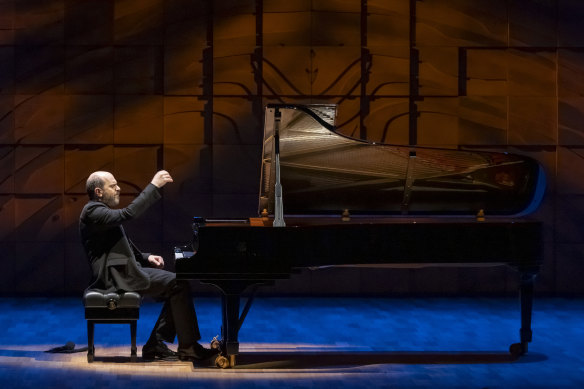
Kirill Gerstein performs at Melbourne Recital Centre, June 11 2024.Credit: James Grant
Fauré’s late, intensely personal Nocturne No.13 in B minor, Op. 119, with its many well-rendered shadings of colour and texture, also sat well with Gerstein’s intellectual inner world. It was preceded by an equally thought-provoking contemporary take on the French master’s music: Après-Fauré No.3: Nocturne by jazz pianist Brad Mehldau.
Poulenc’s extremely varied Three Intermezzi underlined Gerstein’s chameleonic versatility, while Liszt’s Polonaise in E major, S. 233 No.2 left the audience in no doubt as to his pyrotechnical capabilities. Combining just the right proportion of military swagger to romantic swoon, here was a masterclass in technical and expressive control.
Similar accolades were merited for Schumann’s Carnival of Vienna, Op. 26 that concluded the official program. In between came a slightly studious account of Chopin’s Fantaisie in F minor, Op. 49 and Liza Lim’s specially commissioned Transcendental Etude, with its poetic transcendence alluding to the plight of Iranian women through a sound world of overtones and nervous, knotty textures.
Two encores, Kreisler’s Liebeslied Waltz arranged by Rachmaninov and Chopin’s Waltz in A-flat major, Op. 42, had Gerstein in a more relaxed, show-off mode, sending the audience away happy but still pondering the multi-faceted nature of Gerstein’s art.
Reviewed by Tony Way
MUSIC
OneFour: The Get Back Tour ★★★★
Rising Festival, Festival Hall, June 8
On the left of the stage, a sign stating “Welcome to Mt Druitt” sits behind the beat-up, graffitied front end of a car. A short film plays scenes of individuals fleeing the police, of burning buildings, men throwing cash in the air and a mob holding burning sticks. The crowd has their phones poised and ready to capture controversial rappers OneFour as they burst on stage to deafening cheers.
Formed in 2014 in western Sydney, OneFour are praised as pioneers of Australian drill music, a subgenre of hip-hop noted for its minimalistic production and explicit lyrics akin to gangsta rap.

OneFour performs at Rising.Credit: Richard Clifford
It’s rare for the group to tour, in large part due to long-term issues between the group and authorities – in particular, the NSW police, which have claimed their material can incite violence.
The issues – and the impact on OneFour’s commercial success – is well-documented in the 2023 Netflix film, OneFour: Against All Odds. Even the group’s founder, Jerome “J Emz” Misa, expressed his apprehension about their Rising festival gig going ahead.
Performing at Rising were three members of the original group: J Emz, Spencer “Spenny” Magalogo and Salec “Lekks” Su’a. Current member Dahcell “Celly” Ramos was recently charged over an alleged knife threat and former member Pio “YP” Misa (J Emz’s brother) has become an ordained priest.
J Emz leads most of the crowd engagement and storytelling across the set. The crowd turns on their phone torches, illuminating the space as he performs Heartless solo, a softer ballad that was co-written with YP. “You guys know the situation,” he says in his introduction. He later dedicates Welcome To Prison “to those incarcerated right now”.
Due to their limited performance opportunities, you could tell the group gave their all to make the most of it. Bounding across the stage, they spit impassioned lyrics that document inter-gang postcode tensions and the members’ own hardships and religious upbringings.
OneFour’s ongoing struggles to overcome the barriers of race and class ingrained in Mount Druitt’s social fabric are evident throughout their show: in the gunshot sound effects from the on-stage DJ, in the screen’s content with images of violence as well as the lyrics of their music. Even J Emz mentions at one point, “we’re not making it out of the trenches”.

Due to their limited performance opportunities, you could tell OneFour gave it their all.Credit: Richard Clifford
The final song’s arrival felt a little abrupt and without enough warning from the group. The inclusion of softer songs like Heartless and Welcome To Prison showed their emotional range, but the lyrical content could feel a little one-note, as did the maintained high intensity of the rest of the set. However, OneFour’s rawness is part of their appeal.
To say that their music incites violence in its listeners is reductive to those who live with these experiences every day. Their audience engaged with the performance and then left the gig with minimal fuss.
Throughout the performance, there’s a strong sense of community. The group’s crew is often side of stage, filming them and the crowd.
When the final song, Spot the Difference, does come up, the crew members join them in the centre as the crowd jumps so hard that the floor vibrates.
Reviewed by Vyshnavee Wijekumar
The Booklist is a weekly newsletter for book lovers from books editor Jason Steger. Get it every Friday.